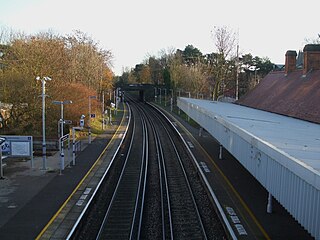Catford loop line
| Catford Loop Line | |
|---|---|
 | |
| Overview | |
| Status | Operational |
| Owner | Network Rail |
| Locale | Greater London |
| Termini | |
| Stations | 8 |
| Service | |
| Type | Suburban rail, Heavy rail |
| System | National Rail |
| Services | 1 |
| Operator(s) | |
| Depot(s) | Grove Park |
| Rolling stock | Class 700 Class 375 "Electrostar" Class 465 "Networker" Class 466 "Networker" |
| History | |
| Opened | 1 July 1892 |
| Technical | |
| Number of tracks | 2 |
| Track gauge | 4 ft 8+1⁄2 in (1,435 mm) standard gauge |
| Electrification | 750 V DC third rail |
| Operating speed | Maximum 60 mph (97 km/h) |
Catford loop line | ||||||||||||||||||||||||||||||||||||||||||||||||||||||||||||||||||||||||||||||||||||||||||||||||||||||||||||||||||||||||||||||||||||||||||||||||||||||||||||||||||||||||||||||||||||||||||||||||||||||||||||||||||||||||||||||||||
|---|---|---|---|---|---|---|---|---|---|---|---|---|---|---|---|---|---|---|---|---|---|---|---|---|---|---|---|---|---|---|---|---|---|---|---|---|---|---|---|---|---|---|---|---|---|---|---|---|---|---|---|---|---|---|---|---|---|---|---|---|---|---|---|---|---|---|---|---|---|---|---|---|---|---|---|---|---|---|---|---|---|---|---|---|---|---|---|---|---|---|---|---|---|---|---|---|---|---|---|---|---|---|---|---|---|---|---|---|---|---|---|---|---|---|---|---|---|---|---|---|---|---|---|---|---|---|---|---|---|---|---|---|---|---|---|---|---|---|---|---|---|---|---|---|---|---|---|---|---|---|---|---|---|---|---|---|---|---|---|---|---|---|---|---|---|---|---|---|---|---|---|---|---|---|---|---|---|---|---|---|---|---|---|---|---|---|---|---|---|---|---|---|---|---|---|---|---|---|---|---|---|---|---|---|---|---|---|---|---|---|---|---|---|---|---|---|---|---|---|---|---|---|---|---|---|---|
| ||||||||||||||||||||||||||||||||||||||||||||||||||||||||||||||||||||||||||||||||||||||||||||||||||||||||||||||||||||||||||||||||||||||||||||||||||||||||||||||||||||||||||||||||||||||||||||||||||||||||||||||||||||||||||||||||||

The Catford Loop Line is a railway line in southeast London. It carries a suburban stopping passenger service from central London to Sevenoaks, and is also a relief route for the Chatham Main Line carrying passenger trains from London Victoria to the Kent coast. There is also much freight activity as this is the main route to Willesden and the north via Latchmere Junction, with intermodal traffic from Thamesport and international workings from Dollands Moor.
The line begins at Brixton Junction,[1][2] where it diverges from the Chatham Main line, and ends when it rejoins the Chatham main line (now extended to pairs of fast and slow lines) at Shortlands Junction,[3][4] west of Shortlands station.
Stations
History
Incorporated as the Shortlands and Nunhead Railway in 1889 it was opened by the London, Chatham and Dover Railway on 1 July 1892. The line left the former Crystal Palace High Level branch and the Nunhead to Lewisham link (the former Greenwich Park branch) at a junction east of Nunhead.
The five stations on the original route were:
The length of the Catford Loop is nearly eight miles (12.5 km).
The line was electrified with the other SECR urban routes on 12 July 1925 by the Southern Railway on its 660 DC third-rail system.
As of 12 January 2015, Southeastern operates an hourly service from London Victoria to Dover Priory over the line; Denmark Hill is the only station on the line called at by this service. All other services originate from London Blackfriars and Thameslink Core and call at all stations.
Services
The service in April 2018 is:
Off-peak / Weekends:
- 2tph West Hampstead Thameslink (London Blackfriars Mon-Fri after 9pm and weekends)
- 1tph London Victoria (Only Calling at Denmark Hill)
- 2tph Sevenoaks via Swanley
- 1tph Dover Priory via Chatham (Only Calling at Denmark Hill)
Peak
- 4tph Bedford / Luton
- 3tph Sevenoaks via Swanley
- 1tph Orpington
From May 2018, there will be an off-peak frequency of 4 trains per hour on the line. Half the trains will run to Sevenoaks via Swanley and half will run to Orpington.
References
- ^ Quail Map 5 - England South [page 3] September 2002
- ^ Network Rail (April 2001). South Zone Sectional Appendix. Vol. Module SO. p. SO110 1/4. SO/SA/001A.
- ^ Quail Map 5 - England South [page 4] September 2002
- ^ Network Rail (April 2001). South Zone Sectional Appendix. Vol. Module SO. p. SO110 1/9. SO/SA/001A.

